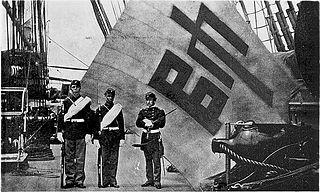
The United States expedition to Korea, known in Korea as the Shinmiyangyo or simply the Korean Expedition, was an American military action in Korea that took place predominantly on and around Ganghwa Island in 1871.
The General Sherman incident was the destruction in 1866 of the American merchant ship SS General Sherman in the Taedong River during an unsuccessful and illegal attempt by the ship's crew to open up trade with the isolationist Joseon dynasty of Korea. With the rapid increase in Western imperialism in Asia during the 19th century, Asian nations came under increasing pressure to end their isolationist policies. Despite China and Japan being forcibly opened to foreign trade by Western powers, Korea maintained its isolationism.
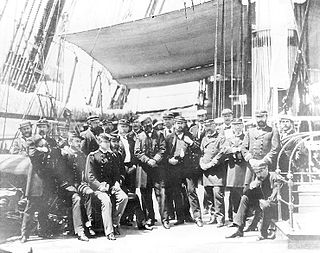
Hugh Wilson McKee was an American naval officer in the 1870s who participated in the United States expedition to Korea in 1871.

The Asiatic Squadron was a squadron of United States Navy warships stationed in East Asia during the latter half of the 19th century. It was created in 1868 when the East India Squadron was disbanded. Vessels of the squadron were primarily involved in matters relating to American commerce with China and Japan, though it participated in several conflicts over 34 years of service until becoming the Asiatic Fleet in 1902.
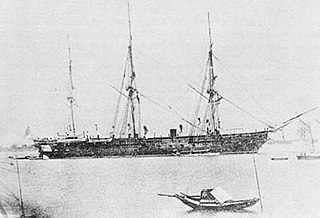
The first USS Colorado, a 3,400-long-ton (3,500 t), three-masted steam screw frigate, was launched on 19 June 1856, by the Norfolk Navy Yard. Named after the Colorado River, she was sponsored by Ms. N. S. Dornin, and commissioned on 13 March 1858, with Captain W. H. Gardner, in command. She was the fifth of the Franklin-class frigates, which were all named after US rivers, except for Franklin.

The Yangtze Patrol, also known as the Yangtze River Patrol Force, Yangtze River Patrol, YangPat, and ComYangPat, was a prolonged naval operation from 1854 to 1949 to protect American interests in the Yangtze River's treaty ports. The Yangtze Patrol also patrolled the coastal waters of China where they protected U.S. citizens, their property, and Christian missionaries.

The Japan–Korea Treaty of 1876 was made between representatives of the Empire of Japan and the Korean Kingdom of Joseon in 1876. Negotiations were concluded on February 26, 1876.

Ganghwa Island (Korean: 강화도), also known by its native name Ganghwado, is a South Korean island in the estuary of the Han River. It is in the Yellow Sea, off Korea's west coast. The island is separated from Gimpo by a narrow channel spanned by two bridges, and from Kaesong (Gaeseong) in North Korea by the main channel of the Han River. North Korea can be seen on clear days from less than two kilometers away on South Korea's Ganghwa Island allowing better views of North Korean villages than from elsewhere in South Korea.
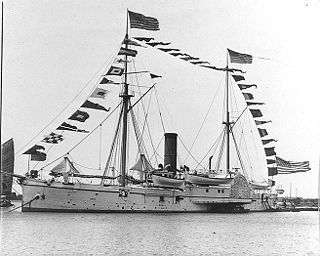
The first USS Monocacy was a sidewheel gunboat in the United States Navy. She was named for the Battle of Monocacy.
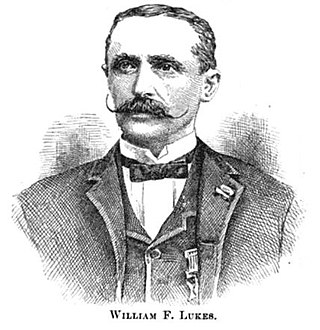
William F. Lukes was a United States Navy sailor and a recipient of America's highest military decoration—the Medal of Honor—for his actions in the 1871 Korean Expedition.

The first USS Palos was a 4th rate iron screw tug in the United States Navy during the late 19th century. She was named for Palos de la Frontera in Spain, the place where Christopher Columbus started the first voyage to America.
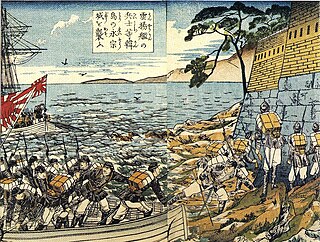
The Ganghwa Island incident or the Japanese Battle of Ganghwa was an armed clash between the Joseon dynasty of Korea and Japan which occurred in the vicinity of Ganghwa Island on September 20, 1875.

The French expedition to Korea was an 1866 punitive expedition undertaken by the Second French Empire against Joseon Korea in retaliation for the execution of seven French Catholic missionaries. The encounter over Ganghwa Island lasted nearly six weeks. The result was an eventual French retreat, and a check on French influence in the region. The encounter also confirmed Korea in its isolationism for another decade, until Japan forced it to open up to trade in 1876 through the Treaty of Ganghwa.
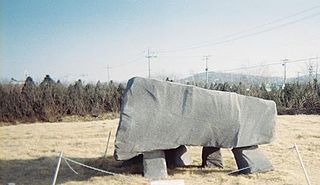
Ganghwa County (Korean: 강화군) is a county in the city of Incheon, South Korea. The county is composed of Ganghwa Island, and the minor islands around it.

The first USS Alaska was a wooden-hulled screw sloop of war, built at the Boston Navy Yard and named for the then-newly acquired territory. The ship was launched on 31 October 1868 and sponsored by Miss Grace Hull, the daughter of Mayor Liverus Hull of Charlestown, Boston. Alaska was commissioned on 8 December 1869, with Commander Homer C. Blake in command.
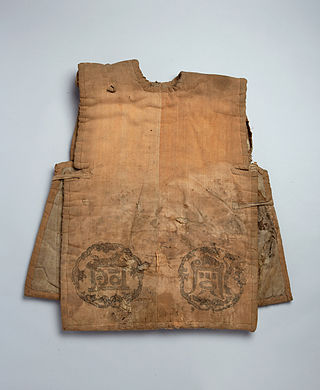
Myeonje baegap (면제배갑, 綿製背甲) was a soft bulletproof vest invented during the Joseon in 1867.

The Sujagi is a flag with the hanja 帥, pronounced su in Korean, that denotes a commanding general. The whole term literally means, "Commanding general flag". Only one sujagi is known to exist in Korea. The color is a faded yellowish-brown background with a black character in its center. It is made of hemp cloth and measures approximately 4.15m x 4.35m.
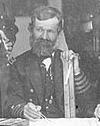
Rear Admiral George Henry Cooper was an officer in the United States Navy. During his long naval career, he served on the African Slave Trade Patrol, and fought in the Second Seminole War, the Mexican War, the American Civil War, and the Korean Expedition, and rose to command of the North Atlantic Squadron.
Eo Jae-yeon was a Korean general who lived during the late Joseon Dynasty. He served as the inspector in the Hoeryong region in 1866 and led the army of Ganghwado Island against the United States military during the U.S. expedition to Korea in 1871.
























